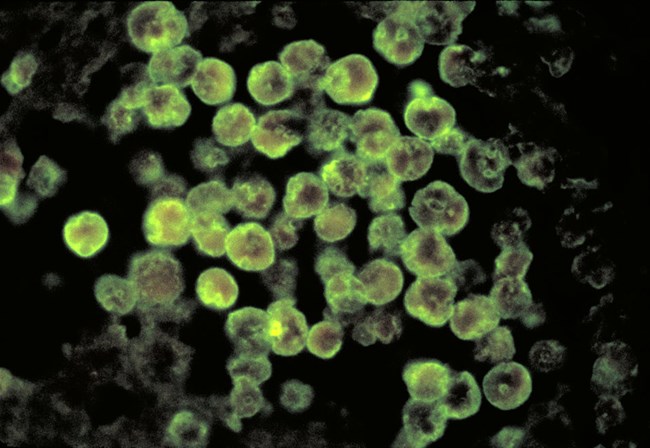Last updated: April 25, 2023
Article
Naegleria fowleri
(This page is part of a series. For information on other illnesses that can affect NPS employees, volunteers, commercial use providers, and visitors, please see the NPS A–Z Health Topics index.)

CDC/ Dr. Govinda S. Visvesvara
Humans: Naegleria fowlerii is a heat-loving single-celled ameba commonly found in soil and fresh water. People can become infected with Naegleria when they go swimming or diving in contaminated warm fresh water. Naegleria infection occurs when the organism enters the body through the nose and travels to the brain, causing Primary Amebic Meningoencephalitis (PAM), which is almost always fatal. Drinking or swallowing contaminated water has not been known to cause infection. The time between exposure to contaminated water and symptom onset may range between 1–12 days. Initial symptoms include headache, fever, nausea, and/or vomiting; symptoms progress to neck stiffness, confusion, seizures, and/or hallucinations. Naegleria infections cannot be transmitted from one person to another. Infections are very rare; between 2011–2022, there were only 33 infections reported in the United States. By comparison, in the ten years from 2001 to 2010, there were more than 34,000 drowning deaths in the U.S.
Animals: Several naturally occurring infections have occurred in cattle, with PAM lesions closely resembling the brain lesions seen in human cases. Infection has also occurred rarely in captive wildlife species (e.g., tapir, black rhinoceros). Animals are not thought to be able to transmit the ameba to humans.
Environment: Naegleria is commonly found in soil and fresh water, including areas such as lakes, rivers, hot springs, and poorly maintained swimming pools. It grows best at temperatures up to 115°F (46°C) and can survive for short periods at higher temperatures. The ameba can survive colder temperatures by forming cysts, though it cannot survive if the water it lives in dries out. Naegleria is not found in saltwater. Posted signage is usually not used to label areas in the environment where Naegleria have been identified; people should assume that Naegleria can be present in warm freshwater bodies across the United States.
PREVENTION
- The risk of Naegleria infection is very low. Still, try to prevent water from going up your nose.
- NPS employees: Maintain adequate chlorination in swimming pools.
- If you become ill following a potential exposure, contact your healthcare provider and let them know of your concern.

- Sheehan KB, Ferris MJ, Henson JM. Detection of Naegleria sp. in a thermal, acidic stream in Yellowstone National Park. J Eukaryot Microbiol. 2003;50(4):263-265. doi:10.1111/j.1550-7408.2003.tb00132.x
